Ever thought if your Cedar cutting board could be more harmful than helpful? Let’s unravel the truth about this stylish kitchen staple together!

Cedar wood is commonly used for many woodworking applications due to its ease of use, pleasant aromatic smell, and visual appeal.
This wood is primarily employed in the manufacture of clothing storage furniture, shingles, musical instruments such as guitars, and paneling.
One day one of my clients asked for making a cutting board with Cedarwood. This piqued my curiosity, as I was already aware of cedar’s characteristic odor.
Consequently, I sought out food specialists and woodworking experts in the San Francisco area for advice.
After receiving excellent guidance and gaining years of experience working with cedar wood, I’ve gathered the following insights on the question: Is cedar good for cutting boards?
Cedar is not good for cutting boards because it is too soft, which allows for easy damage and potential bacteria build-up. Some cedar species also contain toxic compounds. Instead, hardwoods like maple, walnut, or bamboo, known for their durability and resistance to bacteria, are preferred for cutting boards.
But that’s just a quick snapshot.

There are other types of cedar wood that are non-toxic, and these are often used for making cutting boards.
So, in this article, I’ll take a deeper look into cedar cutting boards and answer a few questions such as:
- Advantages and disadvantages of using cedar for cutting boards
- Why cedar wood cutting boards are toxic to humans?
- Why is cedar too soft for cutting boards?
- Red cedar as a cutting board?
- Better woods for cutting boards than cedar
Let’s get going!
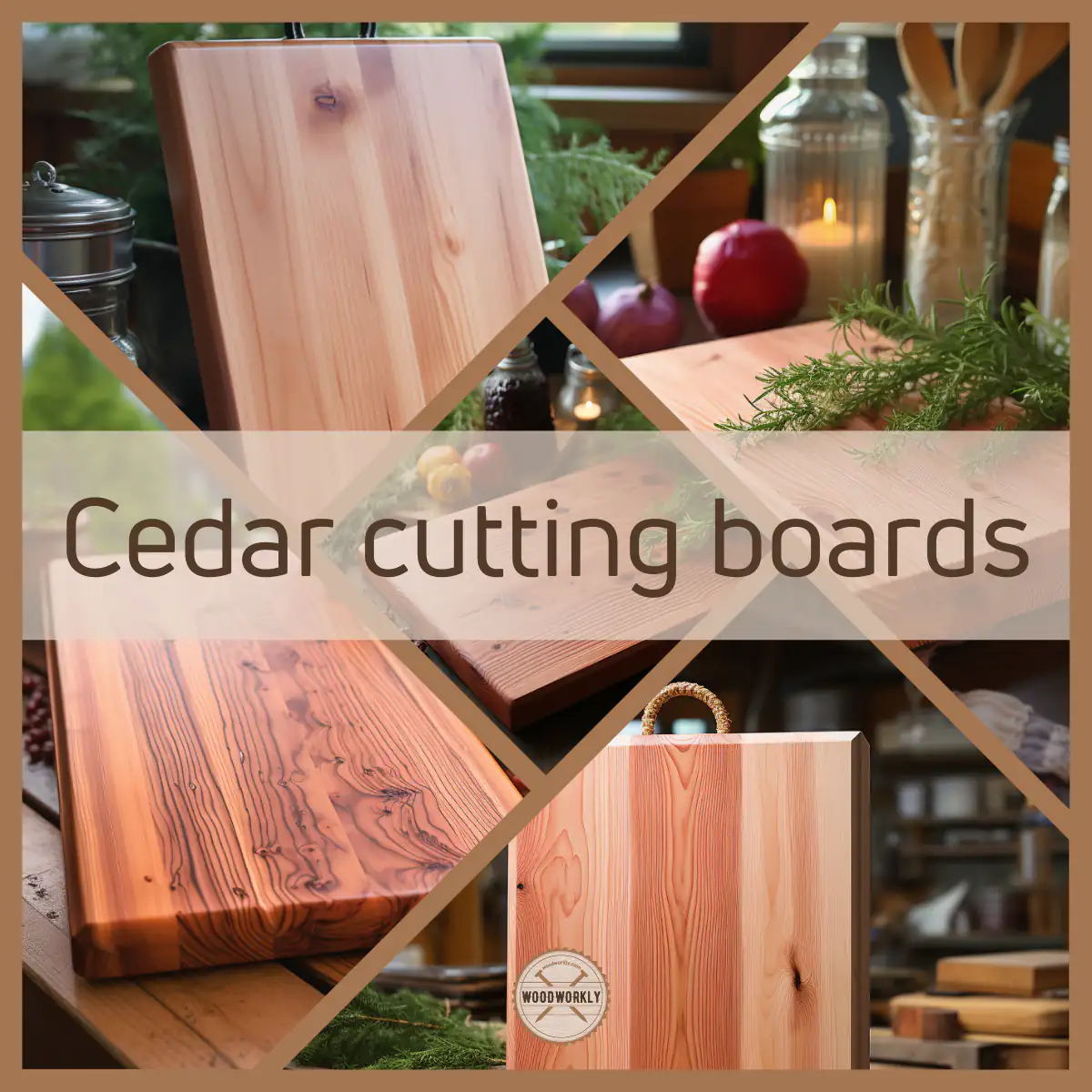
Is Cedarwood Food Safe?
When it comes to the question of cedar wood’s safety in relation to food, it’s not as straightforward as a simple ‘yes’ or ‘no’.
Interestingly, not all cedar wood is the same. There are numerous species of cedar trees, each with their unique properties.
Some cedar wood, like the Eastern Red Cedar, contains a compound called thujone which can be harmful if ingested.
So if you are cutting or preparing food directly on this wood, there is a potential risk involved.
On the other hand, we have Western Red Cedar which doesn’t share this toxic property. In fact, it’s often used for food storage and cooking due to its antimicrobial properties.
Remember that the variety of cedar wood you’re using matters when it comes to food safety.
When in doubt, it’s always safer to consult with a professional or expert before use.
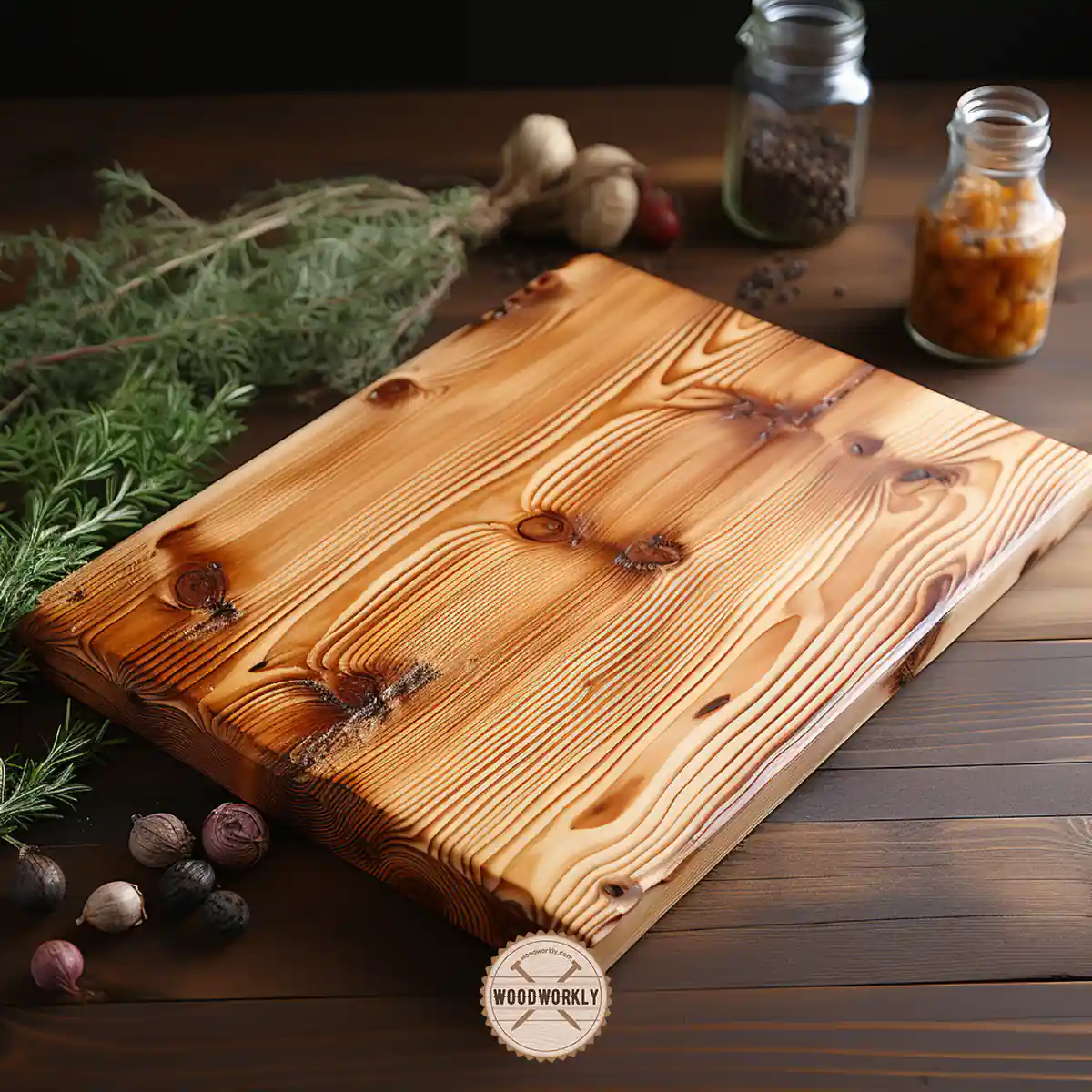
The Dilemma of Cedar as Cutting Boards
One might wonder, if cedar is naturally resistant to decay and rot, doesn’t it make an ideal cutting board?
The reality is a bit more complex. While cedar is indeed resistant to rot and decay, it is a softwood, which means it is not very durable and can easily be damaged by knives.
This creates grooves and cuts in the board where bacteria and other contaminants can be trapped, becoming potential breeding grounds for foodborne illnesses.
Hardwoods like maple, walnut, and bamboo are generally considered better choices for cutting boards because they are more durable and less likely to harbor bacteria.
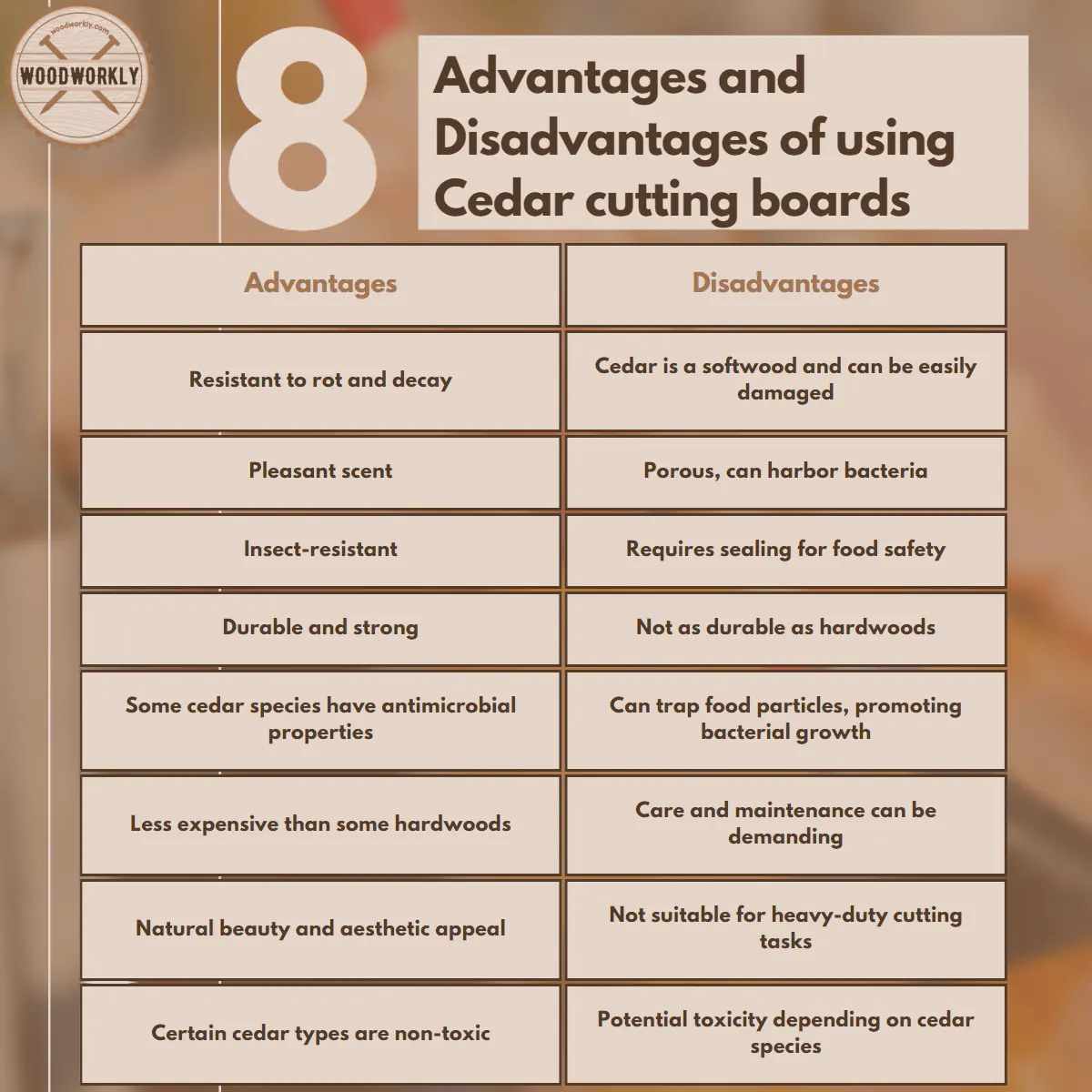
Sealing the Deal: How to Make Cedar Food-Safe
If you’re really insistent on using cedar, you’re not entirely out of luck. With proper treatment, cedar can be made food-safe.
Properly Sealing Cedar
To use cedar as a cutting board, it needs to be properly sealed. A good sealant should be food safe and provide a hard finish that your knife will not breach.
Some of the popular choices include food-grade mineral oil, beeswax, and tung oil.
These sealants not only provide a protective barrier but also enhance the natural beauty of the wood.
The process of sealing cedar involves sanding the wood smooth, cleaning it, applying the sealant, and then letting it dry.
This creates a surface that is resistant to water, rot, and insects and can potentially make cedar safe for food-related use.
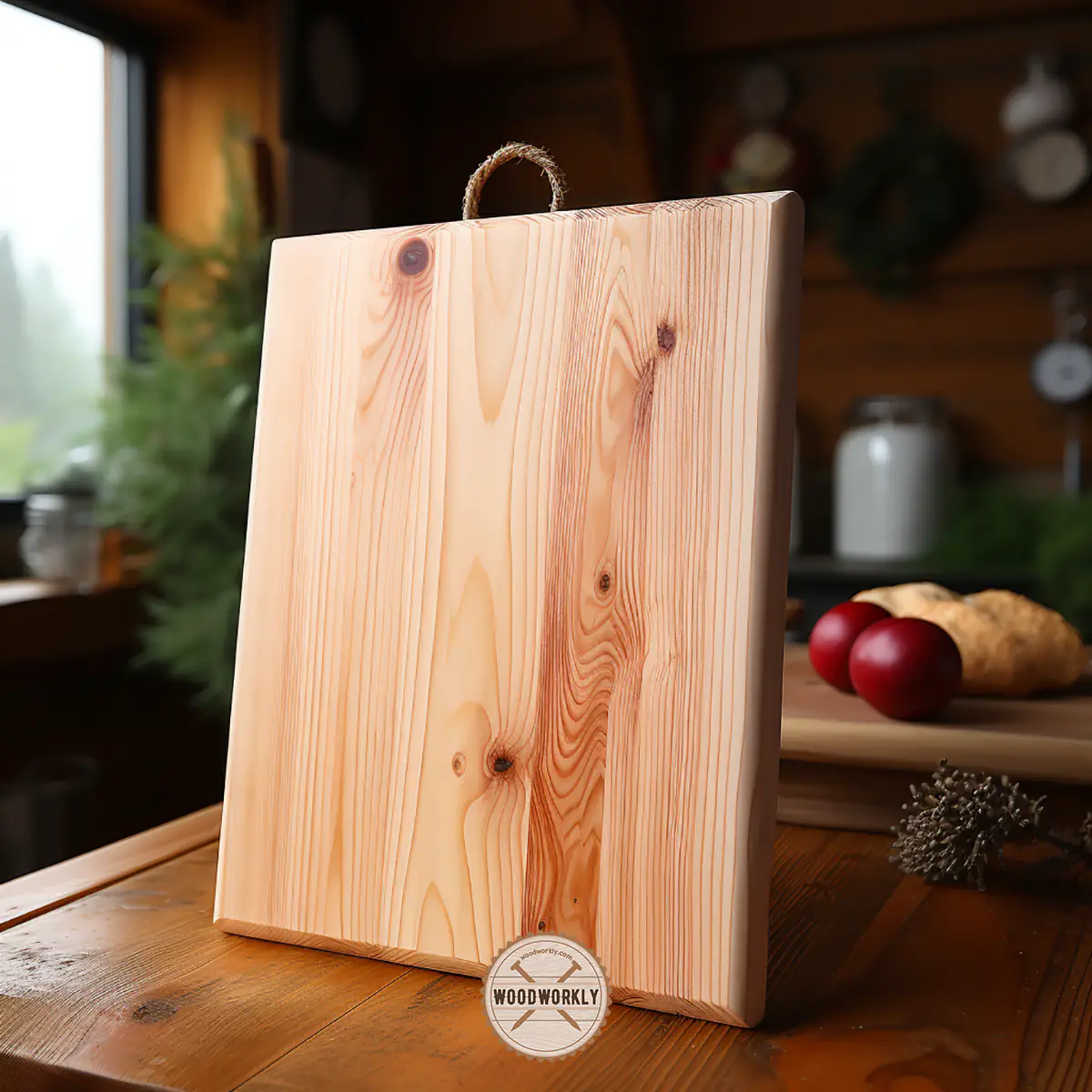
Pros and Cons of Using Cedar for Cutting Boards
After years of working with cedar wood for many projects and researching, here are some advantages and disadvantages of using cedar as a cutting board or as kitchen utensils.
| Advantages | Disadvantages |
| Beautiful and Looks better | Cedar oil is toxic if they contact with food |
| Absorb water quickly and gives less time for bacteria to survive | Too soft for cutting board |
| They are cheaper | Cedar odor can get into the foods |
| warp and rot-resistant | Cedar produces wood slivers in your food |
| Poisonous to bugs | Cedar tannins might darken your fingers and add unpleasant flavor. |
| Lightweight | Less durable |
| Easy to carve | Brittle (Can break easily) |
Ultimately you can see that Cedar cutting boards are good only because they look beautiful. Not good for food applications.
I have mentioned the toxicity of cedar wood. Let’s discuss why they are toxic?
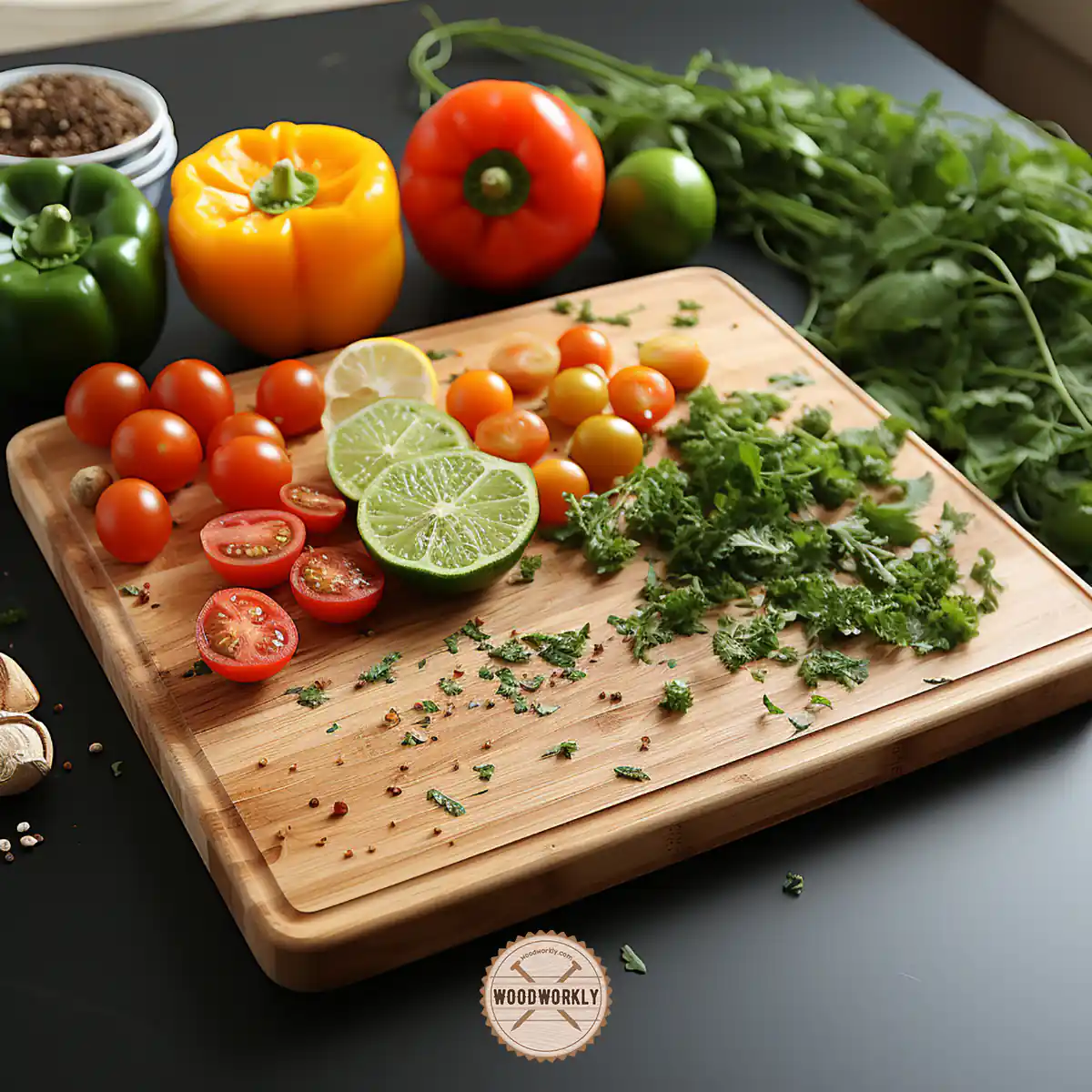
Why Cedar Cutting Boards Are Toxic to Humans?
Cedar wood has its own aromatic oils and toxic compounds to survive in the jungle from bugs, insects, and bacteria.
Because of that cedar wood is poisonous to bugs. Even though we’re super large compared to those species, the poisonous thujone still gets in contact with our foods.
When we use cedar cutting boards, the wood is continuously in contact with the vegetables, fruits, and meat we eat.
We cannot ignore this as a small amount because we use cutting boards daily, which can be poisonous to humans with the use of more and more.
If cedar oil goes inside the human body it can damage our digestive system resulting in vomiting, nausea, and excessive thirst.
Plus, this can cause a runny nose, asthma, etc. The same issues occur with the inhalation of cedar dust when sanding or sawing cedar wood before making a cutting board.
Now you can come up with a question, But All wood dust is risky, right? The answer is yes.
All wood dust is not good for the human respiratory system, but the damage done by aromatic oil-containing woods like cedar is higher than other wood types.
To reduce the risk always wear goggles and a good woodworking mask when making cedar cutting board.
Also, because they are way too soft, the knife cut marks will be there forever. Also, an end-grain cedar will “heal” itself with use. But, because they are too soft, the bacteria get into the pores.
As a result, when we are using cedar cutting board, the bacteria trapped in pores will get a chance to contact with the food, which can be dangerous to humans and for the dogs, and cats we pet.
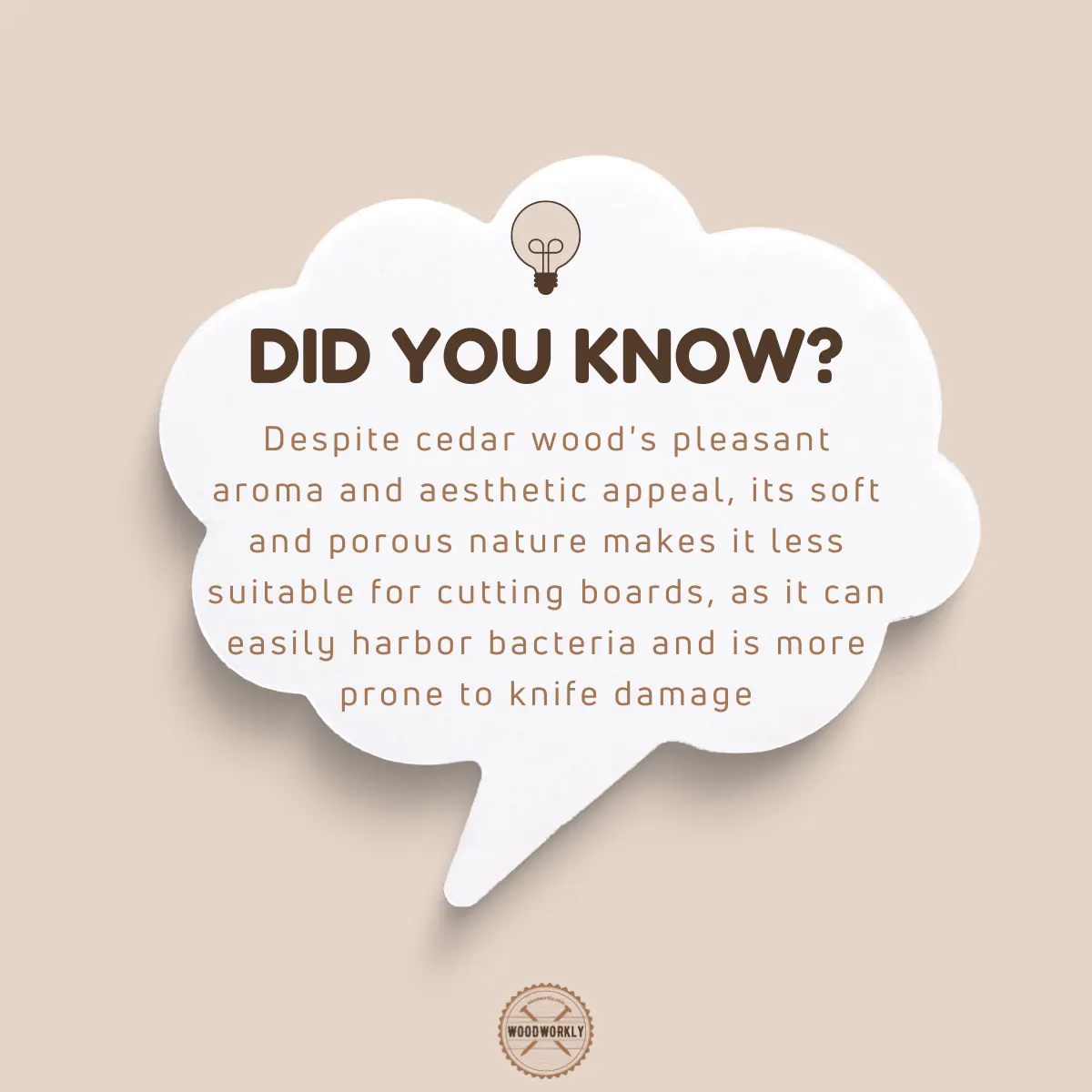
Why Cedar Too Soft for Cutting Boards?
Cedar is a softwood. It is weak and has pretty much low strength compared to maple, which is widely used for cutting boards.
Because of being way too soft the cutting marks of the knife will be very deep and will be very hard to clean.
The following values show numerical values to get an idea about how soft cedar wood is especially for cutting boards, which always have a deal with sharp metals like knives.
- Stiffness – 1.11 Mpsi
- Strength – 7500 psi
- Hardness – 4560 psi
The stiffness, strength, and hardness of cedar wood are very much lower compared to other wood types use for cutting boards.
Because of being too soft, cedar cutting boards will not last long as maple boards.
Cedar cutting boards are very brittle, Drop it once but probably not twice.
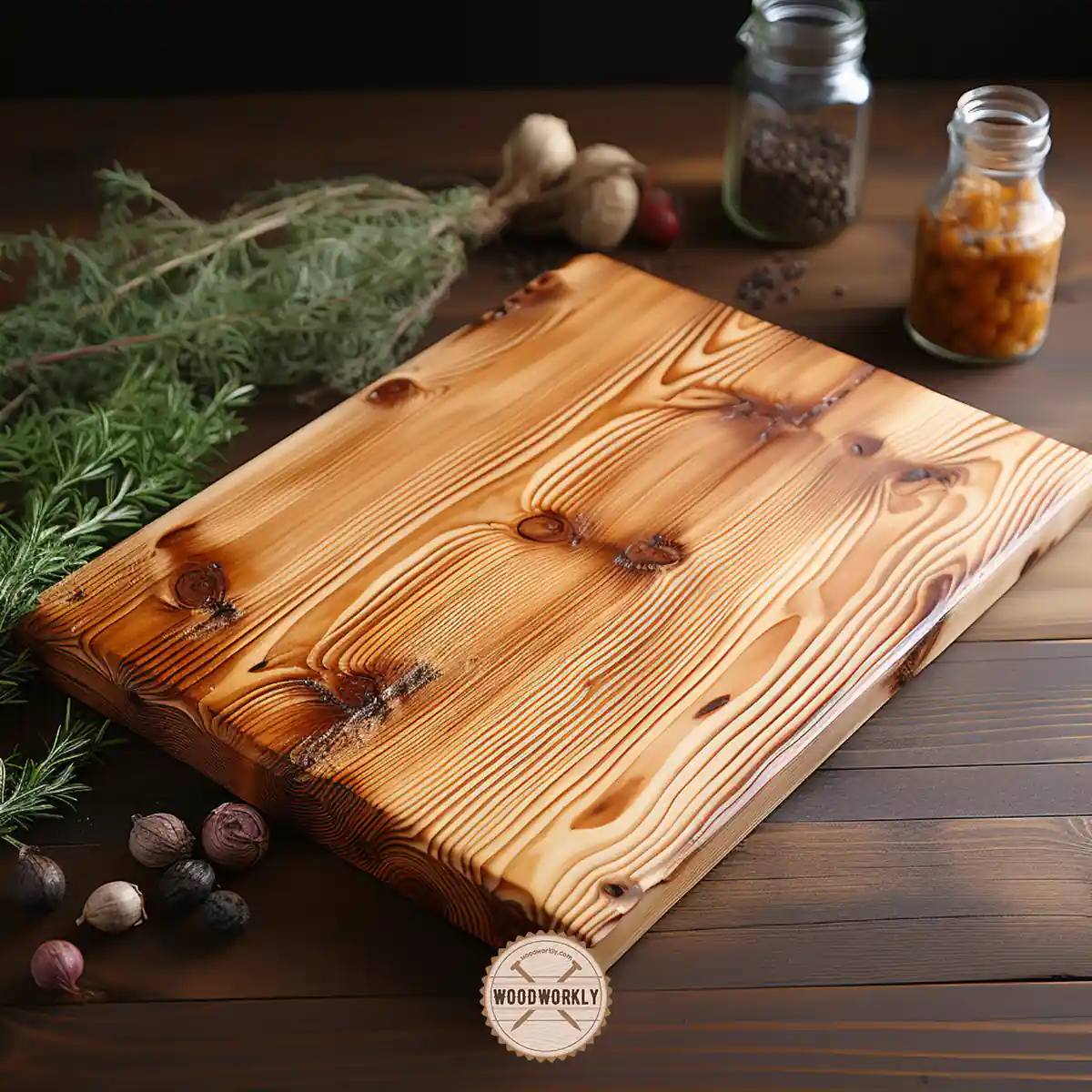
Red Cedar as a Cutting Board?
Red cedar is the most common cedar type that use to make cutting boards.
Why red cedar is so special compared to other types of cedar wood?
Red cedar is beautiful with a fine even texture and the cutting boards made with Red Cedar are smooth, and soft.
Most importantly, most Red cedar cutting boards are safe for food. It gives a nice look to the kitchen.
Their stability is also high. It can last 30-40 years with minimal maintenance.
They have excellent gluing properties and good fastening properties than other cedar wood types. Also, red cedar cutting boards are resistant to extreme cold and heat very well.
The lifetime of red cedar cutting boards is higher compared to other cedar cutting boards.
Red cedar cutting boards have a decent amount of qualities than other cedar cutting boards and they are inexpensive as well. You can buy $1.50 per board foot.
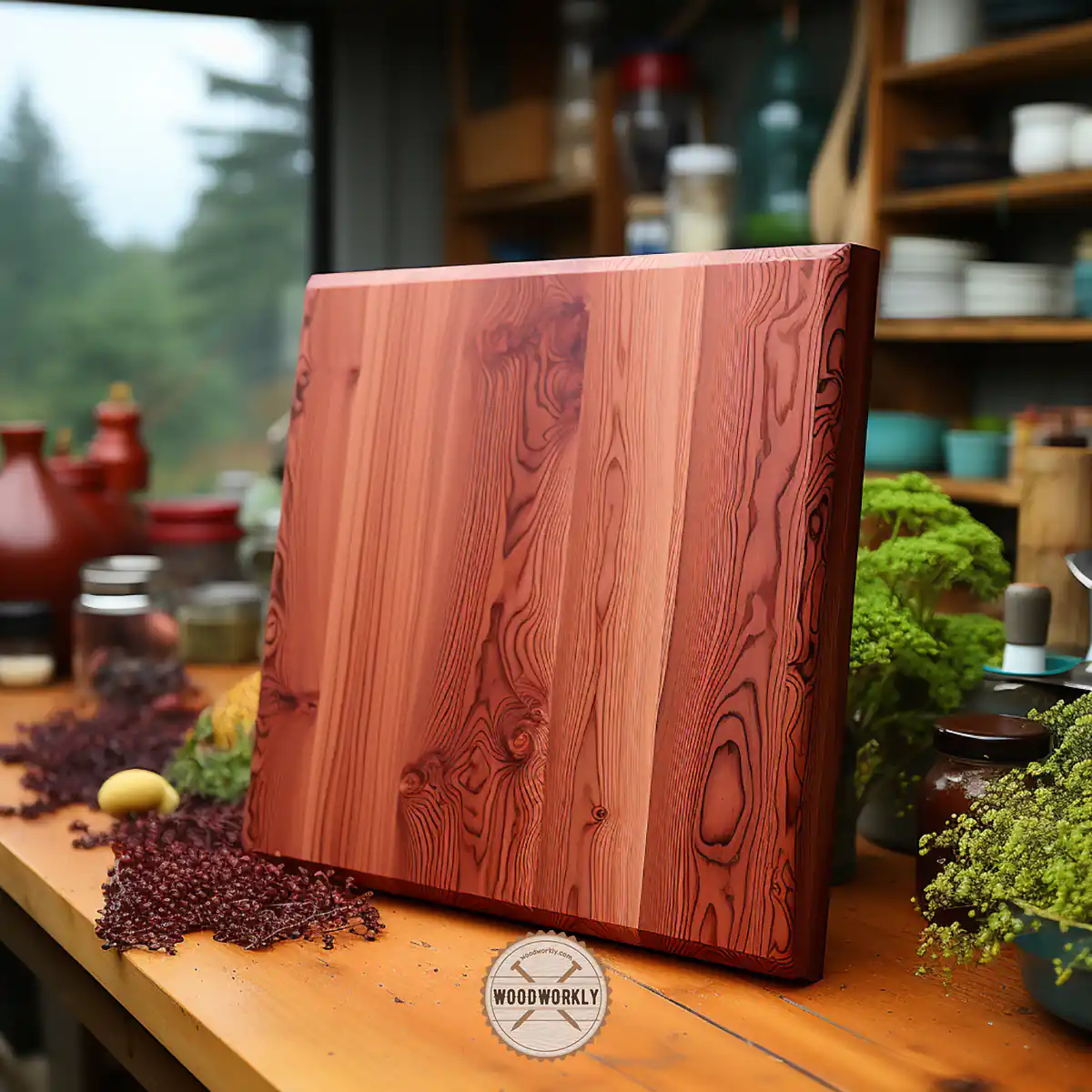
Better Woods for Cutting Boards than Cedar
There are lots of wood types that have so much better qualities than cedar for cutting boards.
By selecting those woods, you will face no issues you faced in cedar cutting boards.
They have higher strength and are non-toxic as well.
Let’s have a look at the Top 3 wood types for cutting boards which you can go directly skipping cedar wood.
Maple
Maple is the best wood for cutting boards. Light in color and gives a natural attractive look as same as cedar cutting boards.
Specially maple cutting boards are very much harder than cedar boards and will not scratch easily with knives.
The small porosity leads to prevent bacteria attachment and safer for the food.
The only issue you will face with maple cutting board rather than using cedar cutting board is maple board need little maintenance once a month because it tends to show stains easily.
Honestly, that’s not an issue with the advantages we can get from the maple cutting board.
You will receive Higher durability, Higher strength, Hard, and much more using maple rather than cedar cutting board.
Beech
The hardness of cutting boards is higher and you don’t need to worry about water absorbance and it getting warped.
It keeps the water out. Beech cutting boards have scratch and impact resistance.
This board is also having small porosity which can prevent bacteria and keep the food safe.
Most importantly it is getting attractive over the years by getting a reddish tint.
The only downgrade you will get from beech cutting boards rather than the cedar board is the beech board shrinks over time.
This can prevent by proper conditioning or with a stain-resistant coating.
Walnut
Don’t you like the shrinkage of cutting boards? Then walnut is the best option because walnut cutting boards do not shrink.
Have a stunning appearance over the years. Need good maintenance than cedar cutting boards.
The main downside is they tend to keep dents and knife marks. Walnut cutting boards are more durable than cedar boards but not as maple boards.
That’s it, folks! hope you got a good understanding of, whether Is cedar good for cutting boards.
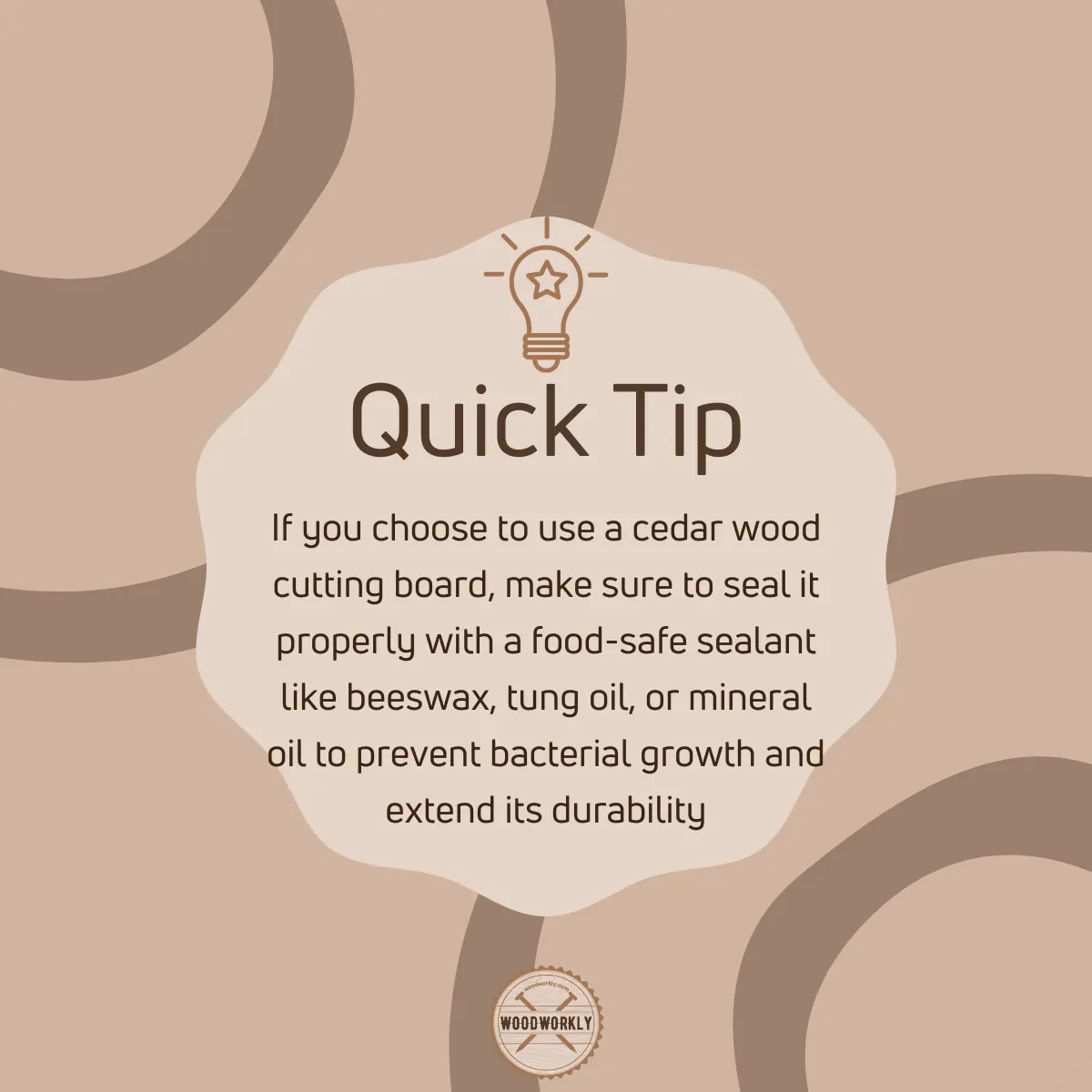
Is Cedar Good for Making Charcuterie Boards?
Cedar is not the best choice for making charcuterie boards.
While it’s beautiful to look at and has a pleasing aroma, its potential safety issues, and practicality concerns make it a less-than-ideal choice.
Instead, consider using hardwoods like maple, cherry, or walnut for your charcuterie boards.
They’re not only safe and durable but also have a neutral scent that won’t interfere with the delightful array of flavors on your board.
Assessing the Safety and Practicality
While cedar’s natural resistance to rot and insects may sound like a good thing, the very same oils that provide these benefits can be problematic when it comes to food preparation and presentation.
As mentioned earlier, some species of cedar contain toxic compounds, making it unsuitable for direct food contact.
Furthermore, cedar is a softwood, which means it’s not as durable as hardwoods like maple, cherry, or walnut.
This means it can be easily scratched or damaged by knives or other utensils, creating grooves where bacteria can linger.
This, of course, poses a potential health risk, especially when you’re dealing with raw and cured meats on your charcuterie board.
The Aesthetic Versus the Practical
The Alluring Scent of Cedar
Now, here’s a fun fact – did you know that the sense of smell contributes significantly to our sense of taste?
That’s why the aroma of cedar might tempt you to use it for your charcuterie board.
However, while the scent might seem appealing, it can interfere with the flavors of the foods on your board.
Imagine trying to savor the subtle flavors of a delicate Brie or a fruity wine, only to have it overpowered by the strong aroma of cedar. This could be a real palate dampener!
The Visual Appeal
Cedar undoubtedly has a visual appeal. Its vibrant colors can indeed make your charcuterie board stand out.
But it’s crucial to remember that aesthetics should not compromise safety or functionality.
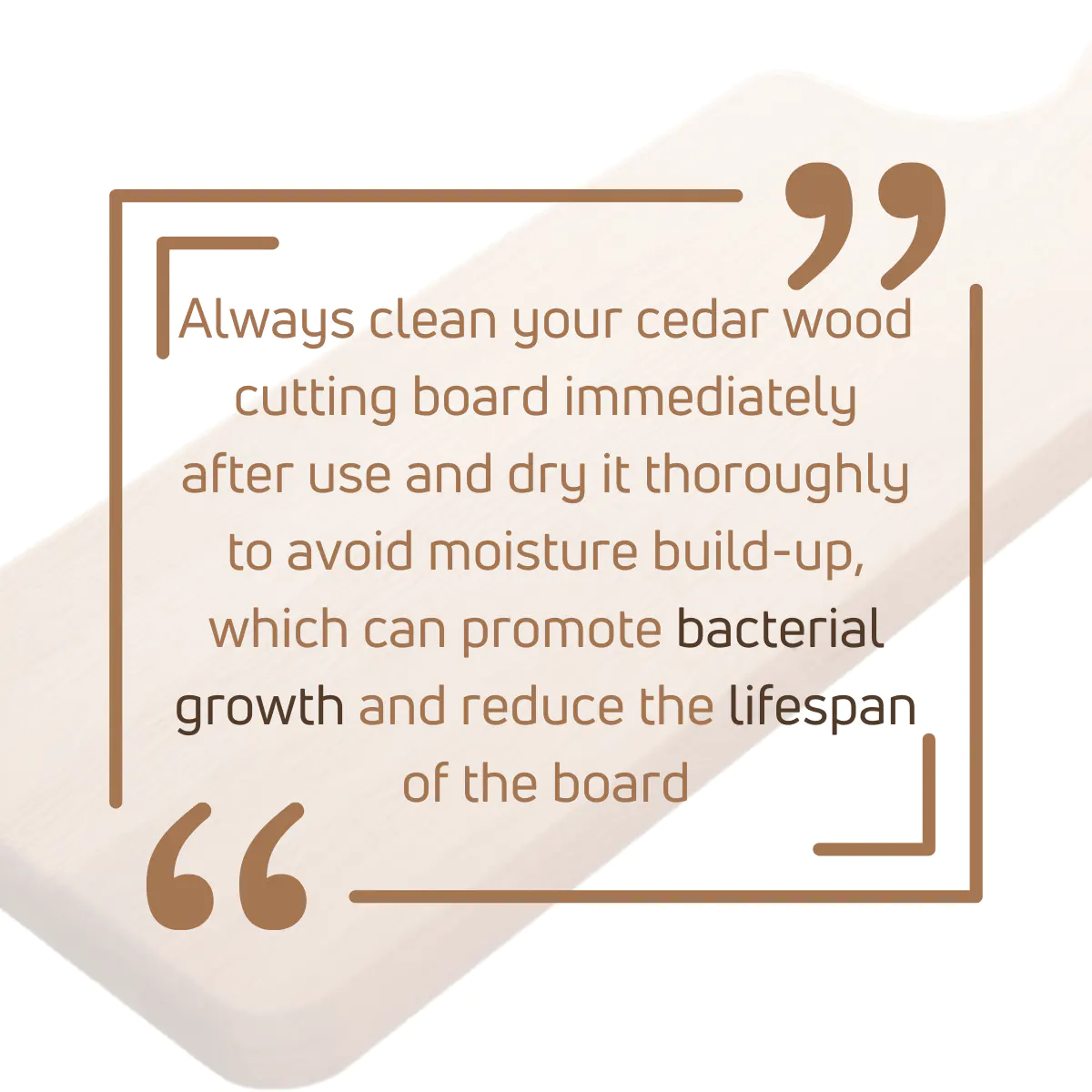
Let’s answer some frequently asked questions.
FAQs
Why isn’t cedar recommended for cutting boards?
Cedar, being a softwood, can easily get scratched or damaged, leading to bacteria buildup; additionally, certain cedar species contain toxic compounds which can leach into your food.
I’ve seen cedar cutting boards for sale. Are they safe?
Some manufacturers may treat cedar to make it food-safe, but it’s always best to confirm with the seller or manufacturer directly to ensure safety.
Can the aroma of cedar affect my food’s flavor?
Yes, the strong aroma of cedar can potentially overpower the taste of your food, altering its flavor profile.
How Do You Seal a Cedar Cutting Board?
You can seal cedar cutting boards using food-grade mineral oil. Apply 3 – 4 tablespoons of mineral oil all over the cedar cutting board.
Apply vigorously by rubbing thoroughly using a cloth rag.
Did I answer all you wanted to know about: Is Cedar Good for Cutting Boards?
In this post, I reviewed the pros and cons of using cedar cutting boards and why I do not recommend using cedar wood for cutting boards.
I’ve deeply discussed why cedar woods are way too soft for cutting wood and what qualities they have to become toxic to humans.
Cedar is not good for cutting boards because it is too soft, cedar oil, and odor can get into food, and cedar tannins darken the fingertips and give an unpleasant taste to the food. Maple and Birch are better than Cedar for making cutting boards.
Furthermore, I have discussed better alternatives we can use for cedar cutting boards. And what makes them specialized for cutting boards and much more.
Hope you got a good knowledge about the pros and cons of using cedar as a cutting board.
If it is only for decorative purposes, it’s all fine. But for daily use, my friend, you need to think twice!